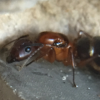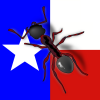Introduction
Camponotus floridanus was one of my dream species when I started keeping ants. Their polymorphism and bright color made me love them. As one of my first colonies, keeping this species is truly a wonderful experience. Floridanus' large size allowed me to easily observe them, from hunting fruit flies to interacting with the larvae. I've learned so much about ants by studying them and I hope to keep them as long as I can.
Late May, 2017
I caught the queen from the black light, after being in the test tube for 3 days, she shed her wings and laid eggs. The color of this queen is on the darker end of the spectrum for this species. The thorax of the queen can very from bright yellow to dark red.

Early July
The first workers emerge after a little bit over a month, the colony is starting and eating well.

August
By this time I've moved them into a small formicarium (Mini-Hearth by THA). The colony is still doing okay but my inexperience with ant keeping didn't allow them to reach their maximum potential. I didn't know how to heat them and was only feeding them weekly.

November 17th
The climate is getting cold but I don't think this species needs to hibernate. I started heating the colony and feeding them a lot more often. The colony is doing much better now and the queen is producing much more eggs than ever. At this time there are around 15 pieces of brood. The surplus of food and some heating helped the colony produce it's first larger larvae, which turned into a pupa (shown in the picture below). Currently I am uncertain if the pupa will eclose into a major or simply a larger worker.

Edited by super_oil, December 5 2017 - 6:10 PM.


















